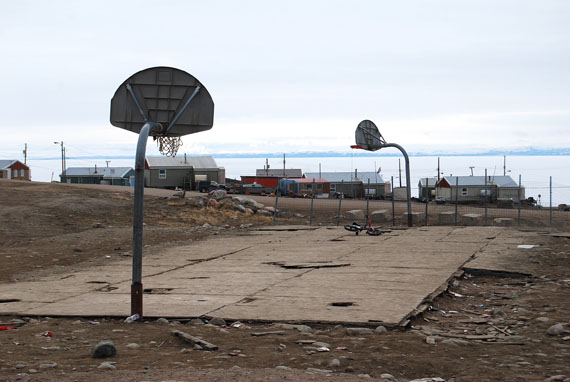Who is failing Pond Inlet?
Youth skeptical about Mary River’s promised benefits

Pond Inlet’s dilapidated outdoor basketball court. (PHOTO COURTESY OF THE AUTHOR)
WILLOW SCOBIE and KATHLEEN RODGERS
University of Ottawa
We have been talking to young people in Mittimatalik-Pond Inlet about their experiences so far with the Baffinland iron mine at Mary River.
We are not the first Qallunaat to arrive in this small community in northern Baffin Island and show interest in their views on the development of a mine at Mary River.
In fact, there have been a lot people flying in over the course of many, many years: the consultants from North Bay, the Baffinland representatives, and researchers working for QIA.
Each group has hired local people to help with the research, to take them out on the land; they have funded community events and talked about the jobs to come for young people.
In Mittimatalik-Pond Inlet, responses to the mine have been mixed. Some are happy about jobs and training, others worry about a negative impact on animals, fishing and hunting; they worry about the prospect of ice breakers, even though they have been promised that there will be no ice breakers. They worry that money and southerners coming through town will flood the community with drugs and alcohol.
At first, the researchers made the community feel hopeful that their views mattered, that their fears and concerns would be heard.
Youth representatives took great care to speak to the young people who were too shy or nervous to attend consultation meetings. Hearing that youth were intimidated by rows of Qallunaat using a lot of technical jargon, Tim Anaviapik-Soucie went to the high school and Arctic College to get the direct input of youth.
Youth joined with elders to map out all of the key sites used historically and at present for hunting, picking berries, fishing, getting to camp, as well as marine and caribou calving grounds.
What came of all of this work? Where did all of this information go?
The little that they do know makes them feel angry. They feel manipulated and misled, and that nothing that they have said has had any impact throughout the eight-year application and approval process.
At first, they felt like they were a part of something that could bring benefits to the community. In the early years of consultation, Baffinland representatives seemed quick to provide financial support for community events like feasts and Christmas parties.
As one man commented, if you spoke to the company liaison officer, “20 minutes later” the cheque was in your hands. As the company moved closer to approval, the money coming directly to the community seemed to decline and it appears to those who continue to apply for funding that Baffinland now focuses on territory-wide, high profile projects.
Young people in Mittimatalik-Pond Inlet say that they desperately need a youth centre and other facilities. They need more infrastructure for the Hamlet and other things in the community.
How badly do they need facilities? As far back as 2006, Abraham Kublu, a member of the recreation committee for the hamlet, decided to set up a “temporary” basketball court in the center of town.
Kublu drove up to the dump to salvage the left-over crate packaging from the dust suppression road salt that Baffinland had shipped in earlier. Kublu laid out the flat wood by the co-op, expecting it would serve as a short-term solution.
Almost 10 years later, the warped wooden court is full of holes that are bigger than a basketball yet still serves as a key play area for basketball, kids on bikes, and a place to meet friends.
Based on the actions and promises of Baffinland representatives during those early visits, many understood that Baffinland was going to make direct investments in infrastructure in the communities surrounding the Mary River site.
Now, however, the anger and frustration is palpable.
The youth that we have met are engaged and passionate about their community. The dominant future scenario that they describe, however, is one where the impact of the mine will mean many losses: close-knit families when some members go to the mining camp to work, an inability to hunt because the mine and the ships will drive away animals, and the fear that use of ice breakers is inevitable.
Natasha Mablick said that, for her, these changes will be “the residential school system” of her generation — a separation from the land and tradition will mean a loss of culture and identity.
For example, having spent time working at the mine, Tim Anaviapik-Soucie describes being searched by security at the entrance of the camp and at having his personal supply of country food confiscated to avoid “contamination” in the meat freezer.
He laughed at the absurdity of it, but it is also profoundly symbolic: no unauthorized ‘Inuitness’ beyond this point.
Mittimatalik-Pond Inlet is not alone in this process. As communities across the North debate the future of mining in their region, they face the same battles.
Here, two things are certain: members of the community feel used and misled, and if they could go back to the beginning they would be suspicious of gifts and promises.
Kathleen Rodgers and Willow Scobie are professors in the Department of Sociology and Anthropology at the University of Ottawa.





(0) Comments